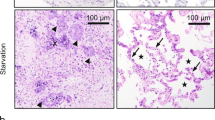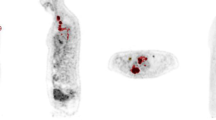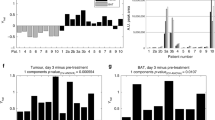Abstract
31P nuclear magnetic resonance (NMR) spectra of cells and of cell extract revealed high levels of phosphorylcholine (PC) and phosphocreatine (PCr) in an adriamycin-resistant human small cell lung carcinoma cell line (GLC4/ADR) and the adriamycin-sensitive parental cell line (GLC4). PCr levels in extracts of GLC4/ADR were increased compared to extracts of GLC4. We estimated that 11% of the total intracellular ATP is not bound to Mg2+ in both cell lines. This value corresponded to an intracellular free Mg2+ of 0.30 mM. The effects of different adriamycin concentrations, 0.05, 1 and 30 microM for GLC4 and 1, 30 and 200 microM for GLC4/ADR, on the phosphorus metabolite levels in continuously perfused cells were monitored. Significant differences between GLC4 and GLC4/ADR included: (a) a strong increase in the beta ATP level in the presence of 30 microM adriamycin in GLC4 only, followed by a fast decrease after 5 h of perfusion. (b) a less dramatic increase in the PC level in GLC4/ADR and an unchanged ATP level in the presence of increasing adriamycin concentrations. (c) an increased GPC level in GLC4/ADR in the presence of adriamycin. The changes in PC and GPC levels in the presence of adriamycin suggested that the phospholipid turnover was increased in GLC4/ADR and could be stimulated in the presence of adriamycin. In both cell lines, PCr levels decreased faster than the ATP levels after adriamycin treatment. Thus, biochemical markers for adriamycin resistance can be detected with NMR spectroscopy. However, more studies are necessary to obtain parameters to distinguish drug-sensitive from drug-resistant tumours in patients by NMR spectroscopy.
This is a preview of subscription content, access via your institution
Access options
Subscribe to this journal
Receive 24 print issues and online access
$259.00 per year
only $10.79 per issue
Buy this article
- Purchase on Springer Link
- Instant access to full article PDF
Prices may be subject to local taxes which are calculated during checkout
Similar content being viewed by others
Author information
Authors and Affiliations
Additional information
This work was supported by the Dutch Cancer Foundation, Koningin Wilhelmina Fonds, grant GUKC 86-01.
Rights and permissions
About this article
Cite this article
de Jong, S., Mulder, N., de Vries, E. et al. NMR spectroscopy analysis of phosphorus metabolites and the effect of adriamycin on these metabolite levels in an adriamycin-sensitive and -resistant human small cell lung carcinoma cell line. Br J Cancer 63, 205–212 (1991). https://doi.org/10.1038/bjc.1991.50
Issue Date:
DOI: https://doi.org/10.1038/bjc.1991.50



